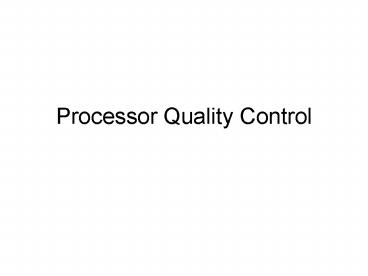Processor Quality Control PowerPoint PPT Presentation
Title: Processor Quality Control
1
Processor Quality Control
2
Automatic X-ray film processor produces dry to
dry films in 90 secs
- To maintain quality attention needed in 3 areas
- Quality control
- Processor cleanliness and cars
- Basic operation
3
Quality Control
- Need to regularly monitor
- Temperature of developer
- Replenishment of film area
- Speed of development cycle (dwell time)
- Film drying temperature
4
Processor Cleanliness Care
- Areas of concern
- Oxidation build up on gears, rollers, tanks
- Crossover guides
- Algae build up in wash tank
- Dirt and dust build up in dryer
- Structural frame, panels lid
- Entry feed tray area
- Oxidisation build up in replenisher tanks
5
Basic Operation
- Necessary to understand operation of
- Transport system
- Recirculation system
- Drying system
- Replenishment system
- Electrical system
6
Daily Check Up
- Before starting
- Remove lid, check chemistry levels
- Shut wash tank water valve, stand pipe in
- Turn on water to desired flow rate
- Check for seized rollers (water to free)
- Power on
- Observe agitation and replenisher pumps operating
- Wait for developer temperature to reach set point
7
Part 2 of Daily Check
- Feed 2 films to clear roller marks (usually 35 x
43 cm cross ways) - Using a nominated step wedge, expose and process
film - Record and compare with standard control film
- If no variation proceed with daily use
8
Using the Step Wedge - Speed
- Determine the step number within a density range
of 1.00 1.30 - Enter step number density on chart
- Use as comparative for all future readings
- Measure and plot density of Speed Step twice
daily - Variations gt 0.15 optical density indicates need
for corrective action
9
Contrast
- Determine densities of steps above and below
Speed Step (or 2 steps) - Subtract densities for contrast reading
- Use same steps for all future readings
- Calculate and plot daily
- Variations of 0.15 optical density need
corrective action
10
Base Fog
- Read area of film that has received no exposure
- Enter reading on chart
- Measure and plot daily. Base Fog should not
increase gt 0.05 optical density from the normal
level.
11
Temperature
- Measure with calibrated thermometer and enter
reading on chart daily. - Variations gt 1 degree C requires attention
PowerShow.com is a leading presentation sharing website. It has millions of presentations already uploaded and available with 1,000s more being uploaded by its users every day. Whatever your area of interest, here you’ll be able to find and view presentations you’ll love and possibly download. And, best of all, it is completely free and easy to use.
You might even have a presentation you’d like to share with others. If so, just upload it to PowerShow.com. We’ll convert it to an HTML5 slideshow that includes all the media types you’ve already added: audio, video, music, pictures, animations and transition effects. Then you can share it with your target audience as well as PowerShow.com’s millions of monthly visitors. And, again, it’s all free.
About the Developers
PowerShow.com is brought to you by CrystalGraphics, the award-winning developer and market-leading publisher of rich-media enhancement products for presentations. Our product offerings include millions of PowerPoint templates, diagrams, animated 3D characters and more.

